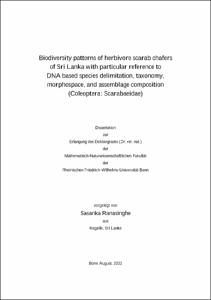Biodiversity patterns of herbivore scarab chafers of Sri Lanka with particular reference to DNA based species delimitation, taxonomy, morphospace, and assemblage composition (Coleoptera: Scarabaeidae)

Biodiversity patterns of herbivore scarab chafers of Sri Lanka with particular reference to DNA based species delimitation, taxonomy, morphospace, and assemblage composition (Coleoptera: Scarabaeidae)

| dc.contributor.advisor | Misof, Bernhard | |
| dc.contributor.author | Ranasinghe, Sasanka | |
| dc.date.accessioned | 2022-11-15T15:00:54Z | |
| dc.date.available | 2022-11-15T15:00:54Z | |
| dc.date.issued | 15.11.2022 | |
| dc.identifier.uri | https://hdl.handle.net/20.500.11811/10434 | |
| dc.description.abstract | Describing and analysing biodiversity and its major patters is key to investigate the underlying processes and causes of diversification. Biodiversity analysis requires proper species inference, knowledge of species assemblage composition, or species turnover across different spatial scales. The thesis consisted of six chapters including DNA-based species delimitation, taxonomy, morphometrics, and synecology.
Four field expeditions were performed for quantitative sampling with multiple UV light traps in Sri Lanka during wet and dry seasons. Standardized sampling encompassed in total 15 localities, covering different forest types, along an elevational gradient (0–2500m). A total of 4901 pleurostict scarab chafer specimen representing 105 morphospecies have been examined. I explored how well COI barcode data reflects morphological species entities and thus its utility for accelerated species inventorization. The study confirmed that COI barcode data alone is unlikely to correctly delimit all species, in particular, when using only a single delimitation approach and suggested the integration of various approaches and data, particularly morphology, to validate species boundaries. A comparison of the outcome based on pairwise match ratios, showed no method neither match the other nor the morphospecies. Furthermore, I investigated how contrasting results of different species delimitations translate into conclusions of synecological studies. Particularly, species estimates based on complete assemblages and on cumulated species inventories inferred from individually analysed subclades were investigated. The study revealed method-related ambiguity of species estimates, which included particularly also subclade inferences, affected severely the certainty of biodiversity patterns at most spatial scales. Haplotypes alone did not reveal as a suitable proxy for biodiversity research. In two additional chapters we described fourteen new species of the Tribe Sericini from Sri Lanka. The descriptions are completed by illustrations of their genitalia and the habitus and included distribution maps and photos of the habitats. Further, new locality records for 33 previously known species were reported and updated the identification key to the Maladera fistulosa group. Sri Lanka comprising now 91 species of Sericini, 81 of them are endemic. In Addition, I investigated the morphospace, morphological disparity, and species diversity for forest types, elevation zones, and each collection site. The results for the first time corroborated a general correlation between morphological disparity and species richness among phytophagous chafers at different ecochorological scales showing contrasting patterns of lineages (the entire assemblage and two sister subclades; Sericini and Pleurosticts excluding Sericini) at different geographical scale. Finally, I investigated the patterns of diversity and turnover of pleurostict chafers across different spatial scales to examine which components determine the assemblage composition, and accessed the influence of lineage membership and body size in shaping the species composition. The results revealed that assemblages were shaped mainly by locality stochastics, and to minor extent by the ecoclimatic conditions. This was true for the entire chafer assemblage but also for all single lineages or different body size classes. The study contributed considerably to the knowledge of scarab chafer biology, including their diversity, morphology, morphospace disparity, factors determining assemblage composition and synecology. | en |
| dc.language.iso | eng | |
| dc.rights | In Copyright | |
| dc.rights.uri | http://rightsstatements.org/vocab/InC/1.0/ | |
| dc.subject | Scarabaeidae | |
| dc.subject | Pleurosticti | |
| dc.subject | Sericini | |
| dc.subject | chafers | |
| dc.subject | Biodiversity | |
| dc.subject | species delimitation,Taxonomy | |
| dc.subject | Morphometry | |
| dc.subject | assemblage composition | |
| dc.subject | Sri Lanka | |
| dc.subject.ddc | 570 Biowissenschaften, Biologie | |
| dc.title | Biodiversity patterns of herbivore scarab chafers of Sri Lanka with particular reference to DNA based species delimitation, taxonomy, morphospace, and assemblage composition (Coleoptera: Scarabaeidae) | |
| dc.type | Dissertation oder Habilitation | |
| dc.publisher.name | Universitäts- und Landesbibliothek Bonn | |
| dc.publisher.location | Bonn | |
| dc.rights.accessRights | openAccess | |
| dc.identifier.urn | https://nbn-resolving.org/urn:nbn:de:hbz:5-68615 | |
| dc.relation.doi | https://doi.org/10.1002/ece3.8942 | |
| dc.relation.doi | https://doi.org/10.5852/ejt.2022.821.1799 | |
| dc.relation.doi | https://doi.org/10.22541/au.166132833.32898410/v1 | |
| ulbbn.pubtype | Erstveröffentlichung | |
| ulbbnediss.affiliation.name | Rheinische Friedrich-Wilhelms-Universität Bonn | |
| ulbbnediss.affiliation.location | Bonn | |
| ulbbnediss.thesis.level | Dissertation | |
| ulbbnediss.dissID | 6861 | |
| ulbbnediss.date.accepted | 03.11.2022 | |
| ulbbnediss.institute | Angegliederte Institute, verbundene wissenschaftliche Einrichtungen : Zoologisches Forschungsmuseum Alexander Koenig (ZFMK) | |
| ulbbnediss.fakultaet | Mathematisch-Naturwissenschaftliche Fakultät | |
| dc.contributor.coReferee | Scherber, Christoph | |
| ulbbnediss.contributor.gnd | 1274951577 |
Dateien zu dieser Ressource
Das Dokument erscheint in:
-
E-Dissertationen (4337)




